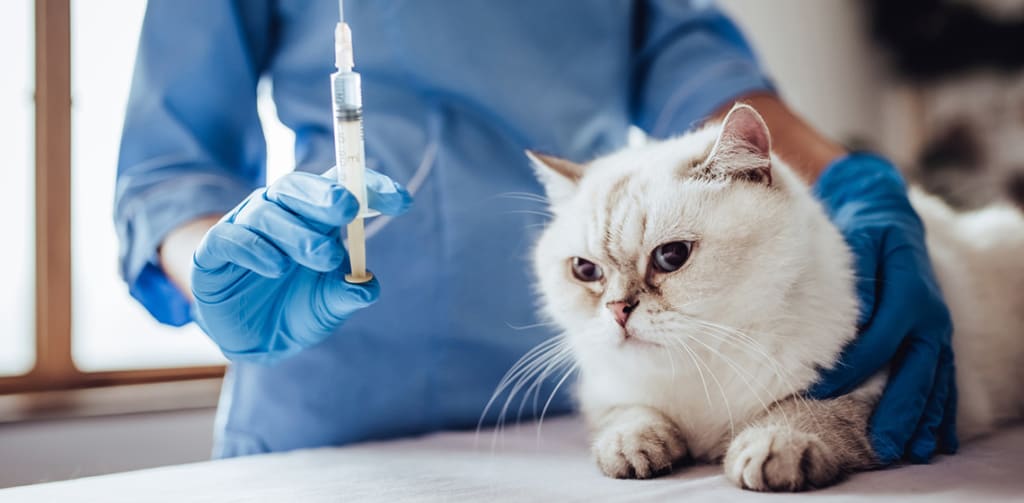Congratulations on your new kitten! Bringing home a new family member is such an exciting time, but it can also be a worrying one, with so much to think about. You probably have questions racing around your head about diet, de-worming, vaccines, and so the list goes on! With so much, often conflicting, information available it can be hard to know what to do for the best. So, let’s start by taking a look at the facts about the FVRCP vaccine.
Table of Contents
What is the FVRCP vaccine?
The Feline Viral Rhinotracheitis, Calicivirus, and Panleukopenia vaccine (FVRCP for short) is a core vaccine for cats. This means that it is recommended for all cats by the World Small Animal Veterinary Association (WSAVA), regardless of their living situation. This is because it protects against serious, highly contagious, and potentially fatal diseases.
How does the FVRCP vaccine work?
Vaccines work by stimulating the immune system to mount a response against the vaccine. So when the immune system encounters the actual virus it “remembers” how to recognize it, respond, and fight it off. Vaccines can be “live,” where a live virus is injected. However, the virus has been modified so that it is weakened and cannot cause disease. Or they can be “inactivated” (also known as “killed”), where the virus is killed by a process of heat or chemicals before injection. They have the same end result, but live vaccines may give longer-lasting immunity, with the possibility of more side effects.
All cats need the FVRCP vaccine. The vaccine protects against three common, serious, and potentially fatal diseases.
What diseases does the FVRCP vaccine protect against?
The FVRCP vaccine protects against three diseases, all of which are very contagious:
Feline Viral Rhinotracheitis
This is caused by a feline herpes virus (FHV-1) and is very common. In fact, it is so common that over 90% of cats are believed to have been exposed to the virus. It causes a very serious cat “flu”, which in some cases can even be fatal, especially in kittens. It is also the most common cause of conjunctivitis in cats.
The most common symptoms are a discharge from the nose, sneezing, lethargy, fever, lack of energy, reduced appetite, plus gunky, red eyes. Infected cats may develop ulcers on their cornea, the surface of the eye. Once infected, the virus stays in the body and can cause a flare-up of symptoms at times of stress, much like cold sores in people. However, some cats can carry, and importantly pass on, the virus without ever having any symptoms.
Calicivirus
Calicivirus is another virus that causes cat “flu.” The symptoms are much the same as for feline viral rhinotracheitis, except calicivirus can also cause nasty mouth ulcers and contribute to inflamed, sore gums. It can also cause lameness and pneumonia, and in very rare cases the whole body is affected, with the potential to be fatal.
Both of these viruses are very contagious and pass from cat to cat through direct contact, through the air, or via contaminated objects.
Even indoor cats should receive FVRCP vaccine as they can still catch these viruses through contaminated objects.
Panleukopenia
This is also known as “feline infectious enteritis” and is caused by a parvovirus. Similarly to parvovirus in puppies, this virus targets the guts and the immune system. It causes diarrhea, vomiting, a lack of appetite, fever, and it can affect the nervous system. Unfortunately, it is a very serious disease, which is often fatal, especially in unvaccinated kittens. It can also cause sudden death, again particularly in kittens.
The virus passes from cat to cat through direct contact, or through contaminated objects.
Does my cat need the FVRCP vaccine?
Yes! The FVRCP vaccine is a core vaccine, meaning all cats should receive it. This is because the FVRCP vaccine protects your cat or kitten against three nasty, common, and potentially very serious diseases.
Even indoor cats should receive it as they can still catch these viruses through contaminated objects. This means they don’t actually need to come into contact with other cats to become infected; the virus could be transmitted on clothes or shoes, for example.
What are the side effects of the FVRCP vaccine?
Luckily, the vaccines are very effective at preventing serious illness or death, and side effects are rare. When they do occur, side effects are usually limited to feeling a little out-of-sorts for a couple of days. Similar to babies after a vaccine, your kitten may develop a mild fever and have a reduced appetite, and the injection site may be sore and a little swollen.
Severe vaccine reactions are rare. All vaccines must pass strict safety and efficacy testing before being licensed for use. Of course, if you are concerned about a reaction to any injection, or have any concerns about your kitten, then please contact your veterinarian for advice.
Is an FVRCP booster necessary?
All kittens, or adult cats receiving the vaccine for the first time, should receive a vaccine course. This involves two or more injections of the vaccine, 3 to 4 weeks apart. After that, cats need regular boosters to ensure they stay protected, as immunity reduces over time. Your veterinarian will be able to advise you on the frequency of the boosters, depending on your cat’s individual needs.
Regular vaccines are a key part of responsible pet parenting and preventative medicine. Your veterinarian will be able to advise you on the best vaccine schedule for your cat, alongside other advice on keeping them fit and healthy… leaving you to relax and enjoy your time with your new bundle of joy!
FAQ
Yes, all cats need the FVRCP vaccine. The vaccine protects against three common, serious, and potentially fatal diseases, so it’s important to ensure that your cat is protected.
Even indoor cats need the FVRCP vaccine, since these viruses can be brought into your home on objects, such as our shoes.
This will depend on which vaccine is used, as well as your cat’s health and lifestyle. Your veterinarian will be able to advise you on the best vaccination schedule for your cat.
FVRCP stands for Feline Viral Rhinotracheitis, Calicivirus, and Panleukopenia. Panleukopenia is also known as “feline distemper” or “feline infectious enteritis.” Before vaccinations, it was one of the leading causes of cat death.

Sarah-Jane Molier wanted to be a veterinarian from around the age of ten. After much hard work, and her first degree in animal science, she realized this dream and graduated in 2009. She has been working in small animal clinics ever since.








